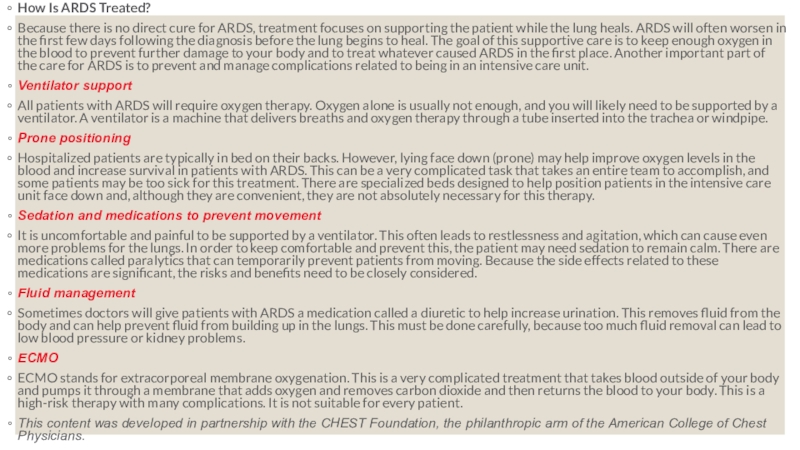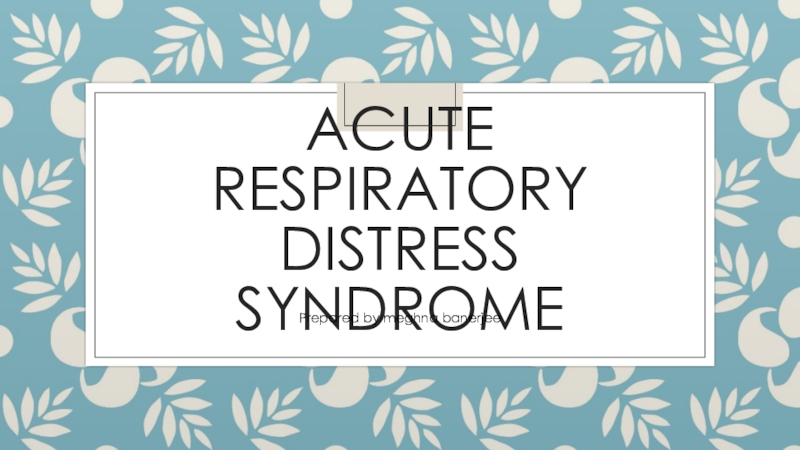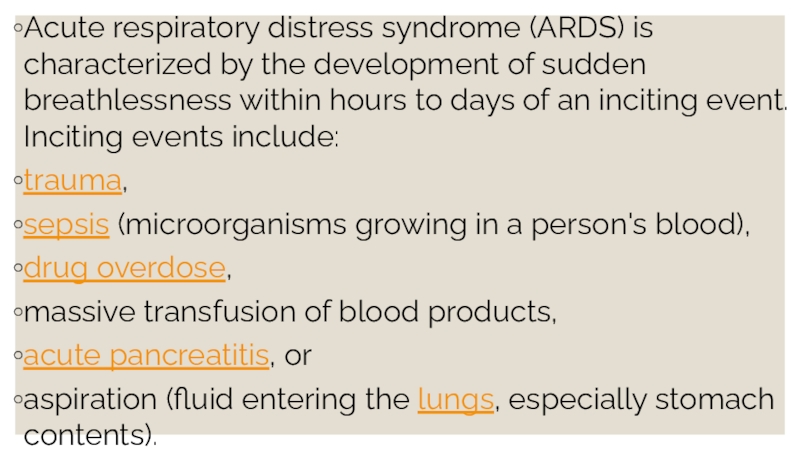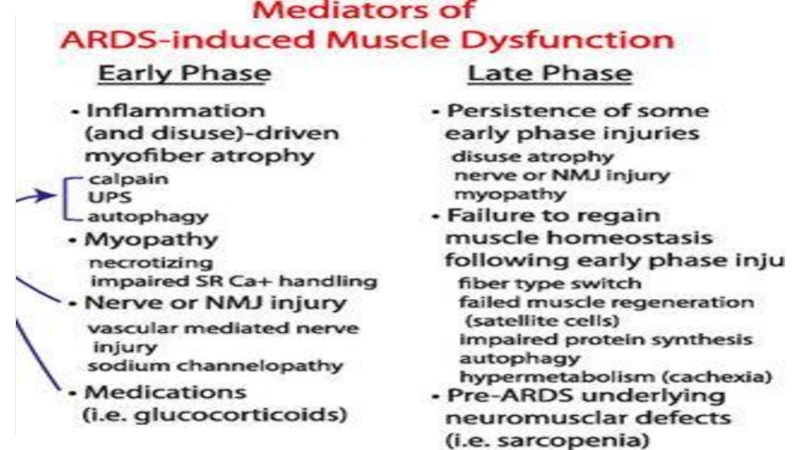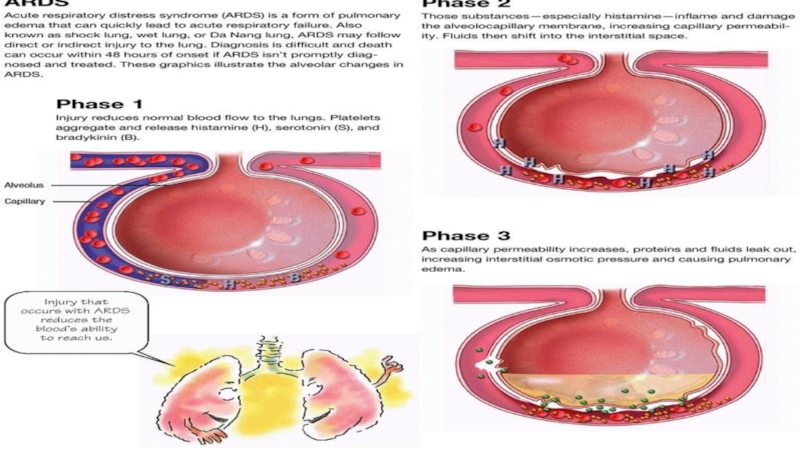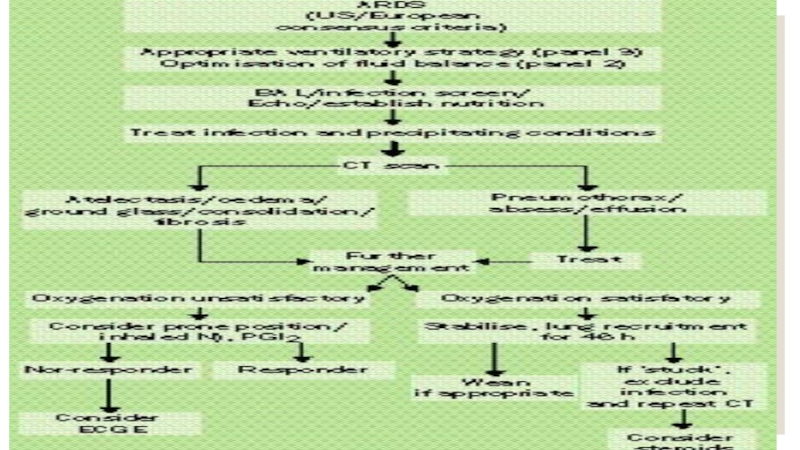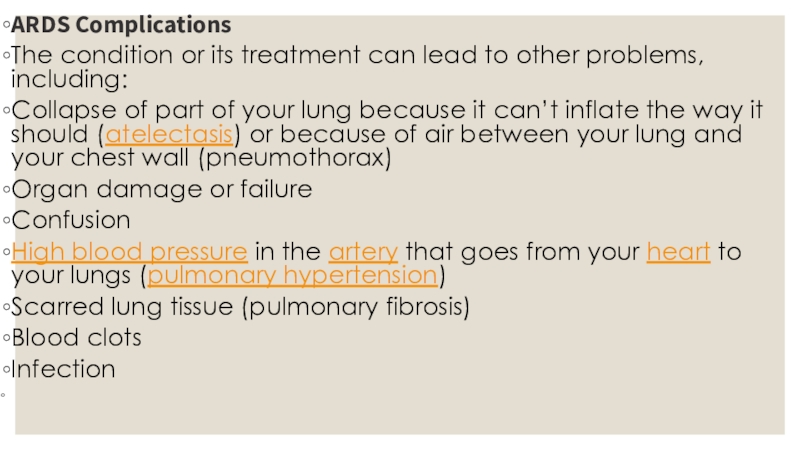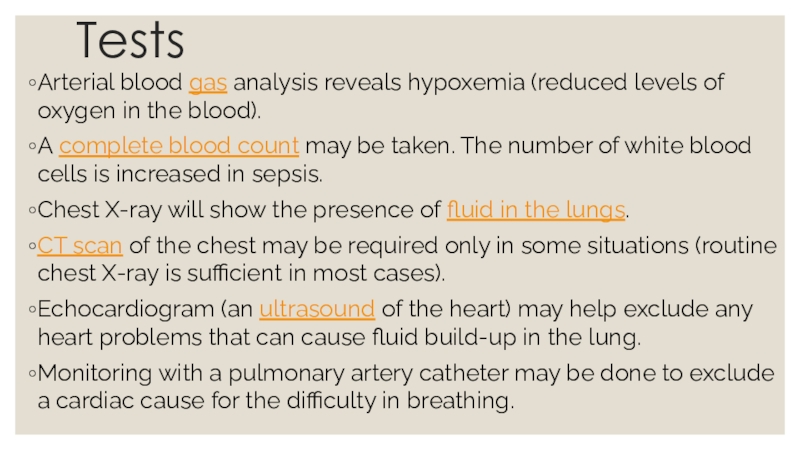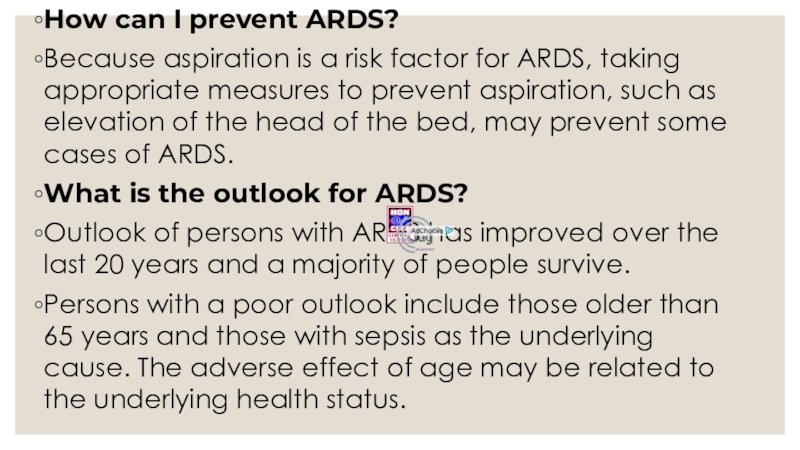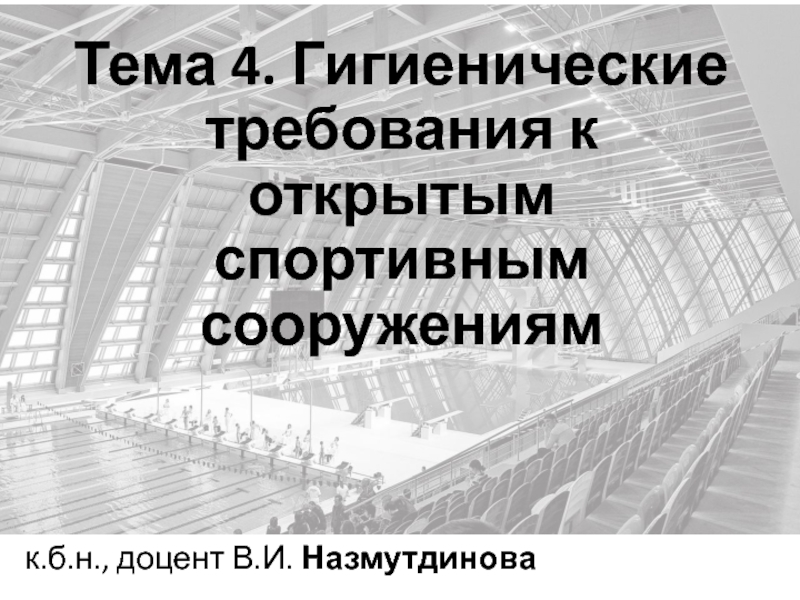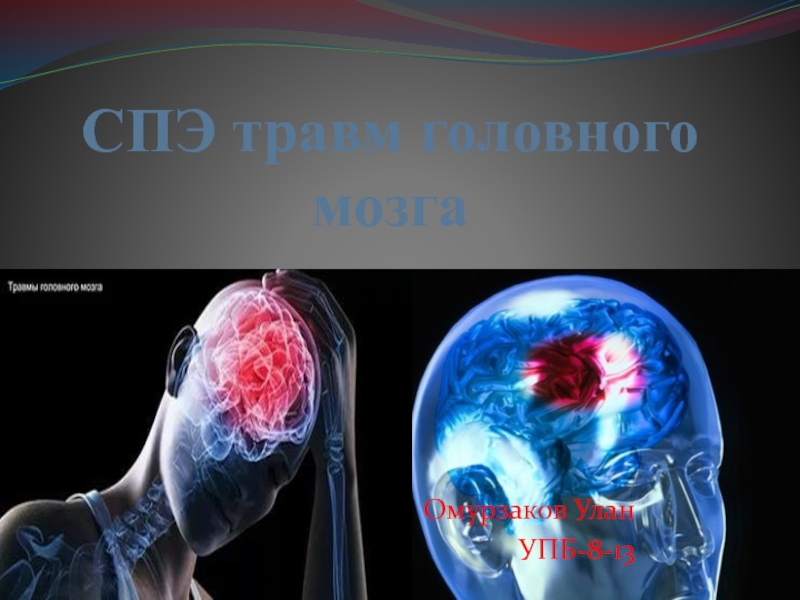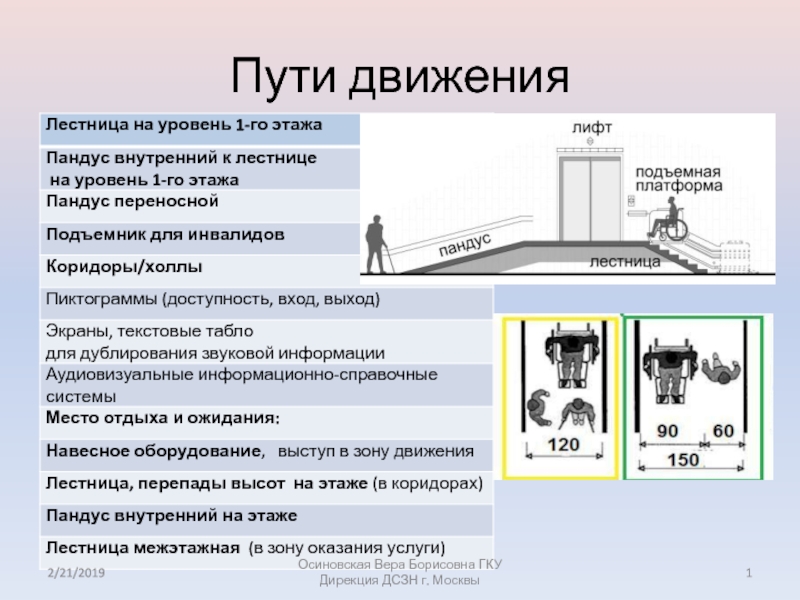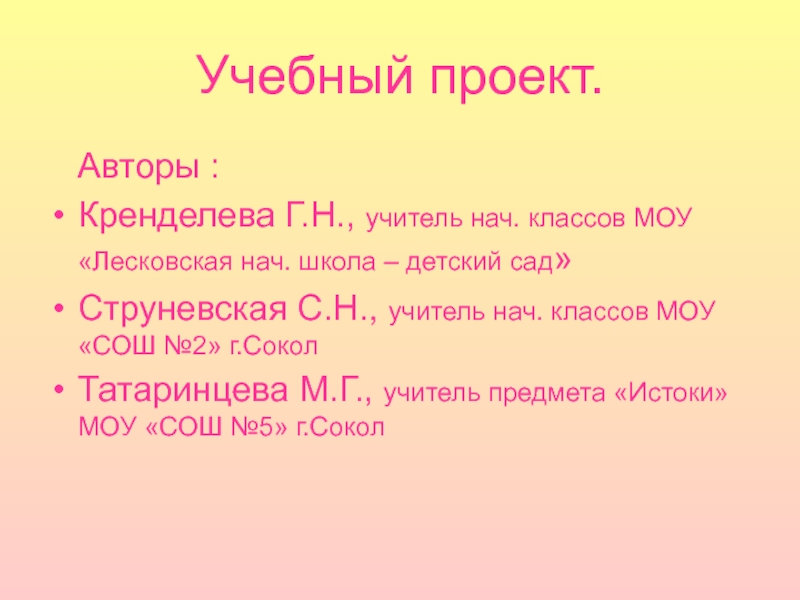Слайд 1Acute respiratory distress syndrome
Prepared by meghna banerjee
Слайд 3Acute respiratory distress syndrome (ARDS) is characterized by the development
of sudden breathlessness within hours to days of an inciting
event. Inciting events include:
trauma,
sepsis (microorganisms growing in a person's blood),
drug overdose,
massive transfusion of blood products,
acute pancreatitis, or
aspiration (fluid entering the lungs, especially stomach contents).
Слайд 4
ARDS Symptoms
ARDS puts a lot of strain on your
lungs. Symptoms include:
Shortness of breath
Low blood pressure
Unusually fast breathing
Fast heartbeat
Cough
Fever
Chest
pain, especially when breathing deeply
Confusion and exhaustion
Blue-tinted lips or nails from lack of oxygen in your blood
Dizziness
Слайд 9ARDS Complications
The condition or its treatment can lead to other
problems, including:
Collapse of part of your lung because it can’t
inflate the way it should (atelectasis) or because of air between your lung and your chest wall (pneumothorax)
Organ damage or failure
Confusion
High blood pressure in the artery that goes from your heart to your lungs (pulmonary hypertension)
Scarred lung tissue (pulmonary fibrosis)
Blood clots
Infection
Слайд 10Tests
Arterial blood gas analysis reveals hypoxemia (reduced levels of oxygen in the
blood).
A complete blood count may be taken. The number of white blood
cells is increased in sepsis.
Chest X-ray will show the presence of fluid in the lungs.
CT scan of the chest may be required only in some situations (routine chest X-ray is sufficient in most cases).
Echocardiogram (an ultrasound of the heart) may help exclude any heart problems that can cause fluid build-up in the lung.
Monitoring with a pulmonary artery catheter may be done to exclude a cardiac cause for the difficulty in breathing.
Слайд 11Treatment
What is the treatment for ARDS?
Persons with ARDS are
hospitalized and require treatment in an intensive care unit.
No specific
therapy for ARDS exists.
Treatment is primarily supportive using a mechanical respirator and supplemental oxygen.
Intravenous fluids are given to provide nutrition and prevent dehydration, and are carefully monitored to prevent fluid from accumulating in the lungs (pulmonary edema).
Because infection is often the underlying cause of ARDS, appropriate antibiotic therapy is administered.
Corticosteroids may sometimes be administered in ARDS or if the patient is in shock, but their use is controversial
Слайд 12How can I prevent ARDS?
Because aspiration is a risk factor
for ARDS, taking appropriate measures to prevent aspiration, such as
elevation of the head of the bed, may prevent some cases of ARDS.
What is the outlook for ARDS?
Outlook of persons with ARDS has improved over the last 20 years and a majority of people survive.
Persons with a poor outlook include those older than 65 years and those with sepsis as the underlying cause. The adverse effect of age may be related to the underlying health status.
Слайд 13Survivors of ARDS may recover normal lung function. However, some
of them may have residual lung impairment or persistent muscle
weakness. Typically, the lung dysfunction is mild, but ARDS can lead to severe lung damage and a reduced health-related quality of life.
Severe disease and prolonged duration of mechanical ventilation are predictors of persistent abnormalities in lung function.
References
ACUTE RESPIRATORY DISTRESS SYNDROME RELATED ARTICLES
Acute and Chronic Pancreatitis
Lungs Picture
Antibiotics (Side Effects, List, Types)
PATIENT COMMENTS & REVIEWS
Acute Respiratory Distress Syndrome - SymptomsWhat were the symptoms of yours, or your loved one's ARDS?
Post View 3 Comments
Acute Respiratory Distress - TreatmentWhat treatment did you receive for Acute Respiratory Distress?
Post View 1 Comment
CONTINUE SCROLLING FOR RELATED SLIDESHOW
Слайд 14How Is ARDS Treated?
Because there is no direct cure for
ARDS, treatment focuses on supporting the patient while the lung
heals. ARDS will often worsen in the first few days following the diagnosis before the lung begins to heal. The goal of this supportive care is to keep enough oxygen in the blood to prevent further damage to your body and to treat whatever caused ARDS in the first place. Another important part of the care for ARDS is to prevent and manage complications related to being in an intensive care unit.
Ventilator support
All patients with ARDS will require oxygen therapy. Oxygen alone is usually not enough, and you will likely need to be supported by a ventilator. A ventilator is a machine that delivers breaths and oxygen therapy through a tube inserted into the trachea or windpipe.
Prone positioning
Hospitalized patients are typically in bed on their backs. However, lying face down (prone) may help improve oxygen levels in the blood and increase survival in patients with ARDS. This can be a very complicated task that takes an entire team to accomplish, and some patients may be too sick for this treatment. There are specialized beds designed to help position patients in the intensive care unit face down and, although they are convenient, they are not absolutely necessary for this therapy.
Sedation and medications to prevent movement
It is uncomfortable and painful to be supported by a ventilator. This often leads to restlessness and agitation, which can cause even more problems for the lungs. In order to keep comfortable and prevent this, the patient may need sedation to remain calm. There are medications called paralytics that can temporarily prevent patients from moving. Because the side effects related to these medications are significant, the risks and benefits need to be closely considered.
Fluid management
Sometimes doctors will give patients with ARDS a medication called a diuretic to help increase urination. This removes fluid from the body and can help prevent fluid from building up in the lungs. This must be done carefully, because too much fluid removal can lead to low blood pressure or kidney problems.
ECMO
ECMO stands for extracorporeal membrane oxygenation. This is a very complicated treatment that takes blood outside of your body and pumps it through a membrane that adds oxygen and removes carbon dioxide and then returns the blood to your body. This is a high-risk therapy with many complications. It is not suitable for every patient.
This content was developed in partnership with the CHEST Foundation, the philanthropic arm of the American College of Chest Physicians.
